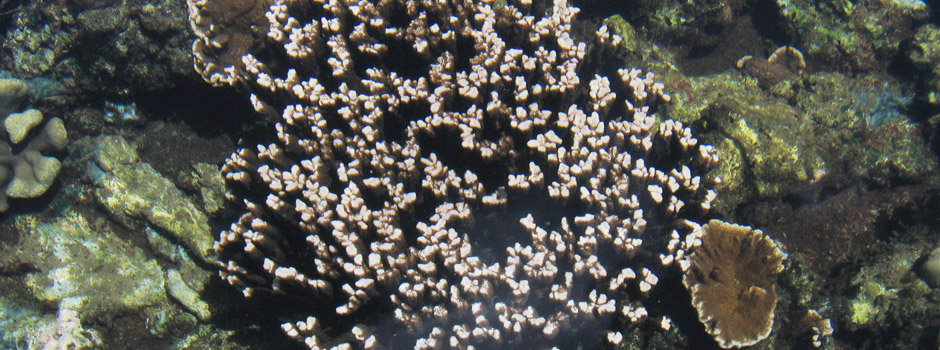Research at the Waikīkī Aquarium is as diverse as the organisms it houses. Research is either in-house by aquarium biologists, or in collaboration with scientists and researchers from the University of Hawai‘i and other institutions of higher learning.
CONSERVATION RESEARCH – PROTECTING SPECIES DIVERSITY
The Protected Resources Division of the Pacific Islands Regional Office of the National Marine Fisheries Service (NMFS) has developed an Endangered Species Act (ESA) Species of Concern (SOC) Program. These comprise species that NMFS has concerns about regarding status and threats, but for which insufficient information is available to indicate the need to list the species under the U.S. Endangered Species Act.
One of the Pacific Islands region species of concern in which the Aquarium is playing a major role in conservation is the Hawaiian irregular rice coral Montipora dilatata.
MONTIPORA DILATATA – The irregular Hawaiian rice coral
Montipora dilatata is a rare coral that has been reported only from the Hawaiian archipelago, more specifically in Kaneohe Bay on the island of O‘ahu, and in the Northwestern Hawaiian Islands at Midway Atoll and Maro Reef.
Following a coral bleaching episode in Kaneohe Bay in the summer of 1999, several large stands of M. dilatata died off and did not recover. A survey of the bay conducted by Waikīkī Aquarium and Department of Land and Natural Resources (DLNR) personnel in May 2000 found only three living colonies. Three samples were taken from one of the colonies: one sample was taken for taxonomic investigation, and the other two samples were each split into two, producing four pieces that were taken back to the Aquarium. At the time of collection, these fragments were approximately 10 cm long and 1.25 cm wide. Two of these pieces were placed in a holding tank in the research area and two were placed on exhibit; unfortunately, the two on display died a few months later.
By 2002, the two fragments in the Aquarium’s research area had increased in size to several colonies over 20 cm in diameter and so it was decided to remove two small colonies into an outdoor public exhibit, the Edge of the Reef, a 26.6 m3 open system containing Hawaiian corals and fishes. Each of these colonies has thrived and increased in size to over 30 cm in diameter and 15 cm in height.
In 2004, the Aquarium received a small grant from the DLNR to construct a “Coral Ark” tank behind the scenes. The purpose of this tank was to house and propagate rare or threatened Hawaiian corals to serve as a genetic and specimen repository as a buffer against extinction in the wild. The first specimen placed in this system was a 10 cm diameter colony of M. dilatata in October of 2004; by March 2007 that colony had reached over 40 cm in diameter and 20 cm high, and consisted of three distinct colonies; a result of incidental fragmentation. Thus, after three years, the fragments at the Aquarium had flourished into healthy colonies, even though colonies in the wild continued to be sparse.
Based partly on this success, in 2006 NMFS awarded a grant to the Aquarium for the construction of a system dedicated toward propagation of M. dilatata. Modeled after other successful coral propagation systems at the Aquarium, the Montipora propagation system is open and uses saltwater from a saltwater well 24 m deep as the sole water source. The chemical and physical characteristics of this water have been described elsewhere (see Atkinson et al., 1995; Delbeek and Sprung, 2005; Delbeek, 2006), but compared to natural seawater it is high in dissolved inorganic carbon, silicate, nitrogen, phosphorous, iron, manganese and a host of other inorganic compounds, but very low in dissolved organics. This makes for accelerated algal growth after initial setup but also excellent coral growth.
To facilitate the placement of coral fragments off the bottom of the tank, plastic shelving mounted onto fiberglass threaded support rods were added, onto which was mounted 25 pieces of M. dilatata fragmented from the “Coral Ark” specimen and ranging in length 5.5 cm to 10 cm. Herbivores (four Hawaiian convict surgeonfish Acanthurus triostegus and ten collector urchins Tripneustes gratilla) were added to control diatom and algal growth. Six months after introduction into the system, the fragments had attached to base rock and had begun to exhibit growth. This has continued unabated and the Aquarium now houses several large, healthy colonies if this species of concern. Thus, 13 years after being collected, the original two fragments at the Aquarium have flourished into multiple, large, healthy colonies, even though colonies in the wild continue to be sparse.
Interestingly, questions raised about the disparate morphologies of separate yet genetically identical colonies of M. dilatata within our tanks have called into question the validity of traditional morphospecies-based taxonomy, and have provided impetus to a detailed genetic-based taxonomic analysis of this genus. The specimens of M. dilatata and other coral species housed at the Aquarium have provided invaluable research material for this investigation. The Aquarium currently is the largest coral propagator, with the largest and oldest coral collection, in the world.



 Donate
Donate
